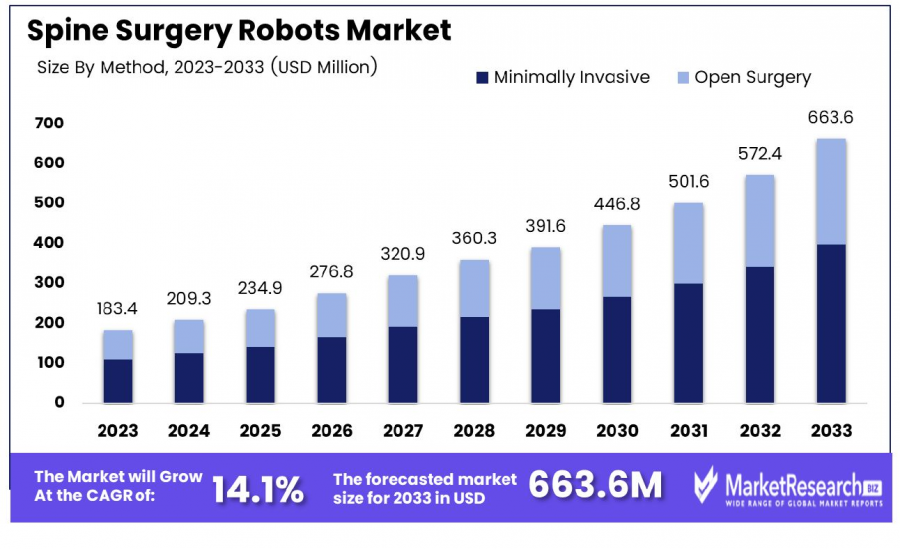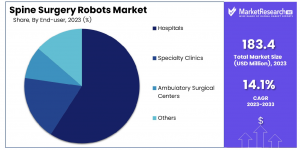
Spine Surgery Robots Market to Witness Strong Growth, Expected to Reach USD 663.6 Mn by 2033
The Global Spine Surgery Robots Market was valued at USD 183.4 Mn in 2023. It is expected to reach USD 663.6 Mn by 2033, with a CAGR of 14.1%
NEW YORK CITY, NY, UNITED STATES, February 18, 2025 /EINPresswire.com/ -- Overview
The Global Spine Surgery Robots Market was valued at USD 183.4 Mn in 2023. It is expected to reach USD 663.6 Mn by 2033, with a CAGR of 14.1% during the forecast period from 2024 to 2033.
Spine surgery robots are transforming spinal procedures by enhancing precision, accuracy, and patient outcomes. These robotic systems assist surgeons in performing minimally invasive and complex spinal surgeries with greater control, reducing risks and recovery time.
Robotic-assisted spine surgery integrates real-time imaging, artificial intelligence (AI), and robotic guidance to ensure precise screw placement and spinal alignment. This technology minimizes surgical errors, reduces radiation exposure, and shortens hospital stays. Leading robotic platforms, such as Mazor X (Medtronic), ExcelsiusGPS (Globus Medical), and ROSA Spine (Zimmer Biomet), are revolutionizing spinal surgery with improved navigation and automation.
The demand for spine surgery robots is rising due to an increase in spinal disorders, a growing elderly population, and advancements in robotic-assisted technology. Studies indicate that robotic-assisted spine surgeries lead to 30-40% fewer complications compared to traditional methods, significantly improving patient safety.
As robotic technology continues to evolve, spine surgery robots are expected to become an essential part of modern spinal care. With ongoing research and development, these systems will further enhance surgical precision, improving both surgeon efficiency and patient recovery rates. The future of spine surgery is driven by robotics, ensuring safer and more effective spinal procedures.
Click here to get a Sample report copy @ https://marketresearch.biz/report/spine-surgery-robots-market/request-sample/
Key Takeaways
•Market Value: The Global Spine Surgery Robots Market was valued at USD 183.4 million in 2023 and is projected to reach USD 663.6 million by 2033, growing at a CAGR of 14.1% from 2024 to 2033.
•By Method: Minimally invasive procedures dominate the market with a 60% share, reflecting a growing preference for less invasive surgical techniques that offer faster recovery and reduced complications.
•By Component: Systems & services hold a 55% market share, driven by increasing demand for advanced robotic platforms, maintenance, and support services to enhance surgical precision.
•By Application: Spinal fusion leads with a 50% market share, highlighting its importance as a key procedure in spinal surgeries, supported by robotic assistance for enhanced accuracy.
•By End-user: Hospitals account for 65% of the market, underscoring their critical role in adopting and integrating robotic-assisted spine surgery into standard medical practice.
•Regional Dominance: North America leads the market with a 45% share, benefiting from advanced healthcare infrastructure, high adoption rates, and strong technological advancements.
•Growth Opportunity: Expansion into ambulatory surgical centers presents a major growth opportunity, as the demand for outpatient spine procedures increases, making robotic surgery more accessible and cost-effective.
Segmentation Analysis
•By Method Analysis: Minimally invasive procedures dominated the Spine Surgery Robots Market in 2023, holding 60% of the market share. These techniques are widely preferred due to their reduced trauma, shorter recovery times, and enhanced precision. The adoption of robotic-assisted minimally invasive procedures is rising as they offer improved surgical accuracy and fewer complications. While open surgery remains relevant, its market share has declined as patients and healthcare providers increasingly opt for less invasive and more efficient surgical solutions.
•By Component Analysis: The systems & services segment led the Spine Surgery Robots Market in 2023, capturing 55% of the market share. This dominance reflects the growing demand for integrated robotic platforms, maintenance, training, and support services. Healthcare providers prioritize comprehensive robotic solutions that optimize workflows and improve surgical precision. In contrast, instruments & accessories, while essential, face competition as hospitals and clinics prefer all-in-one robotic systems that enhance efficiency and patient outcomes.
•By Application Analysis: Spinal fusion was the leading application in 2023, commanding 50% of the market share. This dominance highlights its effectiveness in stabilizing the spine and treating degenerative conditions. Robotic-assisted spinal fusion offers higher accuracy, improved control, and better patient recovery, making it a preferred procedure. Other spine surgery applications, including laminectomy, foraminotomy, microdiscectomy, and kyphoplasty, remain important but face stiff competition due to the broad applicability and success rates of spinal fusion procedures.
•By End-User Analysis: Hospitals held the largest share in the Spine Surgery Robots Market, accounting for 65% in 2023. Their dominance stems from their advanced infrastructure, specialized surgical teams, and high patient volumes, making them the primary adopters of robotic-assisted spine surgery. Hospitals have the resources to integrate robotic systems seamlessly, enhancing precision and patient outcomes. Specialty clinics and ambulatory surgical centers (ASCs) are growing but face challenges in adoption due to high costs and infrastructure limitations.
Market Segments
By Method
•Minimally Invasive
•Open Surgery
By Component
•Systems & Services
•Instrument & Accessories
By Application
•Laminectomy
•Foraminotomy
•Microdiscectomy
•Kyphoplasty
•Spinal fusion
•Others
By End-user
•Hospitals
•Specialty Clinics
•Ambulatory Surgical Centers
•Others
To Purchase this Premium Report @ https://marketresearch.biz/purchase-report/?report_id=47303
Market Dynamics
•Driver: The primary driver of the spine surgery robots market is the increasing demand for minimally invasive surgical procedures. Robotic-assisted spine surgeries enhance precision, reduce recovery times, and minimize complications, leading to improved patient outcomes. The integration of advanced technologies, such as augmented reality (AR) and artificial intelligence (AI), further enhances surgical accuracy and efficiency. These innovations address the growing need for safer and more effective spinal interventions, thereby propelling the adoption of robotic systems in spine surgeries.
•Trend: A notable trend in the spine surgery robots market is the integration of augmented reality (AR) into surgical procedures. AR enhances intraoperative visualization, allowing surgeons to overlay 3D anatomical models onto the patient's body, thereby improving precision in instrument placement and reducing the risk of complications. This technological advancement is gaining traction, as it enhances the surgeon's ability to navigate complex spinal anatomies, leading to better surgical outcomes and increased adoption of robotic-assisted spine surgeries.
•Restraint: Despite the benefits, the high cost of robotic systems and the required infrastructure pose significant restraints on the widespread adoption of spine surgery robots. Many healthcare facilities, especially in developing regions, face financial constraints that limit their ability to invest in such advanced technologies. Additionally, the need for specialized training for surgeons and support staff adds to the operational costs, further hindering the integration of robotic systems into routine spinal surgical practices.
•Opportunity: The expansion of robotic-assisted spine surgeries into ambulatory surgical centers (ASCs) presents a significant growth opportunity. ASCs offer cost-effective surgical solutions with reduced hospital stays, aligning with the patient preference for outpatient procedures. The adoption of robotic systems in these centers can enhance surgical precision and patient outcomes, making advanced spine surgeries more accessible. This shift is expected to drive market growth by catering to the increasing demand for minimally invasive spine surgeries in outpatient settings.
Market Key Players
•Medtronic plc
•Stryker
•Zimmer Biomet
•TransEnterix
•Globus Medical, Inc.
•TINAVI Medical Technologies Co., Ltd.
•Point Robotics MedTech, Inc.
•NuVasive, Inc.
•CoreLink Surgical
•Brainlab AG
•Curexo, Inc.
•Accelus, Inc.
•Synaptive Medical
Regional Analysis
•North America remains the dominant region in the spine surgery robots market, holding approximately 45% market share. This leadership is driven by high adoption rates of advanced medical technologies, a well-established healthcare infrastructure, and strong investments in research and development. Additionally, the presence of key industry players in the region further accelerates market growth.
•Europe follows as a major contributor, with countries like Germany, France, and the UK advancing in robotic-assisted spine surgeries. Government support, rising healthcare expenditures, and technological innovations are fueling growth in this region.
•Asia Pacific is emerging as a lucrative market, supported by expanding healthcare infrastructure, rising disposable incomes, and growing awareness of minimally invasive procedures. Nations such as China, Japan, and India are experiencing an increasing demand for spine surgeries due to the rising prevalence of spinal disorders and a shift toward robotic-assisted treatments.
•Middle East & Africa and Latin America are witnessing gradual growth in spine surgery robot adoption. Improvements in healthcare facilities, rising medical expenditures, and increasing awareness of robotic-assisted surgery benefits are key growth drivers. However, limited access to advanced technologies and strict regulatory policies present challenges to market expansion in these regions.
Emerging Trends in Spine Surgery Robots
The field of spine surgery is witnessing significant advancements with the integration of robotic technology. One prominent trend is the enhanced accuracy in pedicle screw placement. Studies have demonstrated that robot-assisted techniques achieve a precision rate ranging from 93% to 100%, surpassing traditional freehand methods.
Another notable development is the reduction in radiation exposure for both patients and surgical teams. Robotic systems minimize the need for continuous fluoroscopy, thereby decreasing radiation doses during procedures.
The adoption of minimally invasive surgery (MIS) is also on the rise, facilitated by robotic assistance. Robotic platforms enable surgeons to perform complex procedures through smaller incisions, leading to shorter hospital stays and quicker patient recovery.
Furthermore, the integration of real-time three-dimensional navigation with robotic platforms has enhanced surgical precision. This combination allows for meticulous preoperative planning and accurate intraoperative guidance, improving overall surgical outcomes.
Use Cases of Spine Surgery Robots
Robotic systems in spine surgery are primarily utilized for pedicle screw placement. The precision of these systems has been validated, with accuracy rates between 93% and 100%.
In the context of minimally invasive surgeries, robotic assistance has demonstrated significant benefits. For instance, in one- and two-level oblique lumbar interbody fusion (OLIF) procedures, the use of robotics resulted in a reduction of operative time by approximately 50 to 62 minutes, equating to a 16.6% to 17.8% decrease in surgery duration.
Robotic technology is also being explored in the resection of spinal tumors. The enhanced precision of robotic systems aids in achieving complete tumor removal while minimizing damage to surrounding tissues.
Moreover, the integration of robotic systems has been associated with economic benefits. A study indicated that the application of robotic spine surgery could lead to immediate savings of approximately $608,546 annually, attributed to factors such as reduced revision surgeries, lower infection rates, decreased hospital stays, and shorter operative times.
Explore More Healthcare Reports
Nocturia Market-https://marketresearch.biz/report/nocturia-market/
Oncology Information Systems Market-https://marketresearch.biz/report/oncology-information-systems-market/
Sperm Bank Market-https://marketresearch.biz/report/sperm-bank-market/
Stethoscope Market-https://marketresearch.biz/report/stethoscope-market/
Smart Syringes Market-https://marketresearch.biz/report/smart-syringes-market/
Sharps Containers Market-https://marketresearch.biz/report/sharps-containers-market/
Sharps Safety Market-https://marketresearch.biz/report/sharps-safety-market/
Scleroderma Diagnostics and Therapeutics Market-https://marketresearch.biz/report/scleroderma-diagnostics-and-therapeutics-market/
Pressure Ulcers Treatment Market-https://marketresearch.biz/report/pressure-ulcers-treatment-market/
Prenatal Vitamin Supplements Market-https://marketresearch.biz/report/prenatal-vitamin-supplements-market/
Schizophrenia Market-https://marketresearch.biz/report/schizophrenia-market/
Respiratory Inhaler Market-https://marketresearch.biz/report/respiratory-inhaler-market/
Lawrence John
Prudour
+91 91308 55334
email us here
Distribution channels: Healthcare & Pharmaceuticals Industry
Legal Disclaimer:
EIN Presswire provides this news content "as is" without warranty of any kind. We do not accept any responsibility or liability for the accuracy, content, images, videos, licenses, completeness, legality, or reliability of the information contained in this article. If you have any complaints or copyright issues related to this article, kindly contact the author above.
Submit your press release


